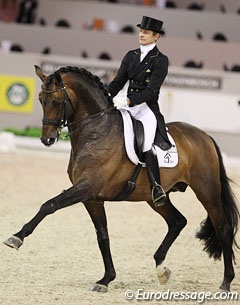
Is there such a thing as the perfect position? As a young rider I admire many people for their ability to ride with what I deem perfection. Edward Gal is one rider whose hips and legs, and well every part of him really, seem to just float with the horse. But when I asked him about his riding, he said of course there are things he has to work on everyday. I certainly can't find them, but the point is that even the TOP riders have their faults.
We all have something we do, that no matter how much we think about it, or how much we are reminded to fix it.... if we forget about it for even a second, there it is again!
Research is constantly being updated with what is considered the most effective dressage riding position for optimum performance, and this means the training must also adopt to the new information.
For example the traditional instructors tell us that our feet should face forward parallel with the horses body...However modern instructors know that to fully allow movement and relaxation in the hip and leg, the toe should point slightly outwards...
So what used to be considered aeroplane feet is now correct.
I suspected as much after seeing the effectiveness of the rider with most probably the best leg and hip based dressage seat in the world! Having watched Edward Gal's brilliance first hand at the 2010 Dressage Forum in Portugal, it struck me just how much his toes fly out to the side. That began my research into position... Wanting to answer the question of what is actually, as opposed to theoretically, right?
It made me wonder about whether the perfect position can actually ever truly be put into theory, or even ever be obtained, because doesn't a rider's position, to be truly effective, need to adapt specifically to the particular horse, on the particular day, and to his particular way of going in those conditions?
Does Edward Gal ride every horse the same as he rode Totilas? Or did he have the PERFECT position for that horse, but must then change things slightly as the different horses require?
Reiner Klimke was also a man I very much look to for riding talent, and when you see his technique it is vastly different from that of Gal's, however he moves his entire body with the flow of the horse, and Edward does the same but in a different direction.
Can it be that the key to a good rider is not a text book of what it should look like, but the ability to establish a seat that in no way prohibits the horse from fulfilling that particular horse's full range of movement and potential?
The best articles I have read from experts theorizing position, link the rider's ability to the objectives of the horse. This makes perfect sense to me, because isn't the aim of dressage to create harmony with the horse...to become one! One such expert, Richard Wies, has presented at clinics for the German, Dutch, Australian and New Zealand Equestrian Federations on his main area of knowledge, the DRESSAGE riding TECHNIQUE.
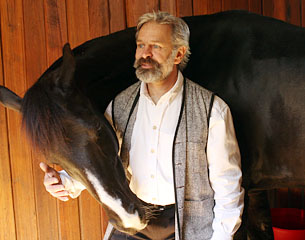 I wondered given the title of his studies, that perhaps ‘position’ is a book with no chapters, a cover with nothing inside, and that riding technique may actually have little to do with the way a rider should look on the horse.
I wondered given the title of his studies, that perhaps ‘position’ is a book with no chapters, a cover with nothing inside, and that riding technique may actually have little to do with the way a rider should look on the horse.
Presenting at the prestigious 2003 Global Dressage Forum in Holland, and announced Technical Advisor to the judges at the first National Finals of the 'Sit Competition' for the Dutch Association of Riding Schools, Richard works with a full range of students, from beginners of all ages to Olympians (from five countries) and Paralympians. With articles published extensively in many of the leading Equestrian Magazines - St Georg (Germany), The Horse Magazine & Hoofbeats (Australia), Ridehesten (Denmark), Bit (Belgium), British Dressage (UK), Dressage Today (USA), Johbe Life (Japan), Hoofschlag (Netherlands), I thought Richard was the perfect person to ask about this interesting topic.
When I first approached the master he agreed that the term 'position' in itself is very limiting, and that my study into the perfect position was a term that restricts us as riders to understand everything that encompasses the Dressage Riding Technique.
"Position is a confusing term, suggesting something static, something you might adopt for a photograph,” says Richard. “Riding is dynamic and dance like. So I would use the more open term - the Seat. Of course the ‘perfect seat’ is extremely adaptable. All the features of the German training scale can be communicated to the horse through specific functions of the seat.”
On his website Richard details how each level of the German training scale can be applied effectively through the functions of the rider's seat. Meaning that everything the rider is attempting to achieve in their own seat should be exactly the same objectives that is required and perfected in the horse...ie, a seat training scale? Just as there is self-carriage in the horse there is also self-carriage in the rider. A rider must therefore balance perfectly so that the horse will not distribute his own weight unevenly.
“If we want to talk ‘ideals’ we are certainly far more helpful to the horse if we manage perfect balance,” says Richard. “Balance is something we can’t fix or freeze. And even balance in relation to the locomotion has a swag of meaning to the horse. Most basically, if you are in perfect balance the horse is getting reassurance to continue as he is.....no changes necessary.”
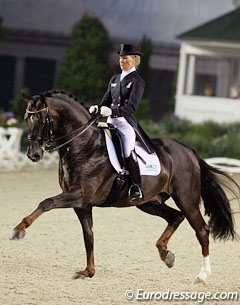 However the dressage riding technique is complex, and requires that the rider shift their point of balance under certain conditions.
However the dressage riding technique is complex, and requires that the rider shift their point of balance under certain conditions.
“An example of being momentarily out of balance for a specific effect would be weighting the inside stirrup for bend,” says Richard. “Once the horse adjusts itself balance is reinstated with bend. The horse balances under the rider. The rider makes suggestions but ultimately the horse operates like a juggler to stay underneath us. A half halt is just saying get back underneath me, carry me,” says Richard.
So as we make subtle shifts in our balance to accommodate our desires, the horse reacts, listening to our seat and moving his body in unison.
In an article Richard co-wrote with Susanne Miesner, ‘The Posture Does the Riding”, the pair outline how an efficient rider can distribute the effort and the energy evenly through their body without restriction and is thus able to adjust themselves to every feeling and with little effort can generate big results.
“A rider who can distribute this effort evenly through his whole body (and?) does no more and no less than the minimum required. The body is toned in such a way that it acts as a spring. Too much tone and it becomes stiff and jars, too little and it sags and flops. The same is true for the horse. True suppleness requires positive tone. The ability to adjust the tone in the body and to readily redistribute it is fundamental to riding. (The Posture Does the Riding, Weis and Miesner 2001)”
The effective rider can then allow the power of the horse to flow through openly and without restriction from the back to the front, just as the energy flow of the rider will begin in the foot and float up through and out the top of the rider's head.
It all makes sense, to create harmony with our horse, we must work in the same way, like two entities working on their individual halves, that when brought together make a whole. A rider can then go through the steps, from Rhythm through to Collection, and just as the horse will reach Grand Prix, a rider to can reach their point of technical efficiency.
I love the way Richard describes this harmony as a dance between horse and rider, as we feel the balance and find the rhythm to express this energy.
“When the horse is traveling the rider needs to synchronize, to ‘go with the movement’. On gross levels this is say the bounce of trot. On subtle levels it incorporates the direction of travel and the specific oscillations of the horses back and rib cage, and of course the movements of the horses head and neck. It’s a dance. Every impulse that flows between the rider's body and the horse's body and back again affects the overall way of going. If dance is a movement discipline then so is riding. Learning to ride is a study of movement. Learning to ride dressage is a study of posture and movement,” says Richard.
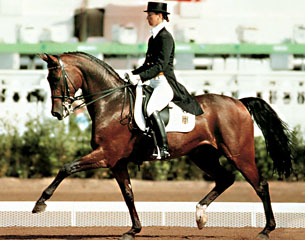 I wondered then, that if dressage is like a dance, and we create music with the horse, can there be certain riders who are 'one hit wonders', who can ride one horse to absolute perfection, but never achieve an effective seat on any others? Richard says he does not believe that the ‘one hit wonders’ concept exists in dressage, but he does agree that certain horse and rider pairs are just meant to be.
I wondered then, that if dressage is like a dance, and we create music with the horse, can there be certain riders who are 'one hit wonders', who can ride one horse to absolute perfection, but never achieve an effective seat on any others? Richard says he does not believe that the ‘one hit wonders’ concept exists in dressage, but he does agree that certain horse and rider pairs are just meant to be.
"It is fair to say some body types (phenotypes) can fit to the movement of some horses better than others," Richard explained. "In addition some temperaments find a simpatico to form a seemingly blessed partnership."
This made perfect sense to me, considering I once owned a SUPER calm little warmblood/pony cross, who would do ANYTHING I asked of him in competition; flying changes, piaffe, passage, etc. BUT, he was a horse that needed to know the person riding him, and would not even let a stranger catch him in a stable! Thus I pose the question: does a horse's natural tendencies need to be accommodated by the rider? Whether it be for personality or morphology?
If a horse is naturally a stresser, does the rider need to take more time to get to know him, become 'friends' with him on the ground to gain his trust in the saddle? And if a horse is naturally built with a downward energy flow, does the rider need to lift this energy up off the shoulders, and if so does this alter their point of balance on this particular horse?
“Riders weight can be distributed from the back to the front of the saddle to accommodate the horse's way of going,” says Richard. “If synchronizing is the aim you might go in forward seat on a horse that is going downhill. Of course you might choose to ask that same horse to move its centre of gravity back. In that case you’ll take the lead by applying a half-halting seat.”
If a horse and rider pair can learn the dance of the dressage riding technique, and have established the perfect balance and harmony, does the rider then need to have amazing feeling to apply this balance to different horses, on different days?
“I saw a young guy back a thoroughbred in a 12 metre rubber round yard,” says Richard. “The horse pretty much turned itself inside out and the guy stayed put....artfully! I was later amazed to find out he couldn’t ride. He was a very good surfer living inland and went in search of the same sort of buzz. He had no interest in riding, just exceptional athleticism and balance. One of my manuscripts is called ‘The Feel Factor-An ideal rider training’. They say you can’t teach ‘feel’ but we all know you can by helping riders develop awareness, first of themselves and secondly of the horse. Riding hundreds of horses is a bloody good way to learn and so is cultivating a deep sensate calm with an intense listening ethos.”
So the Master says that while some riders have natural feeling, others may learn this art over years of concentration, and for some, their natural physique allows this feeling to create harmony and also athleticism in the horse.
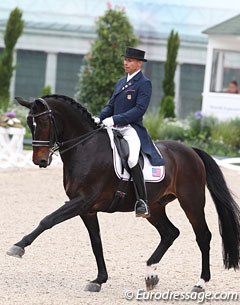 “Steffen Peters rode for me in the All Star Show Case at Equitana a few years ago. I liked his clarity, his balance, and his fairness. I particularly liked that he is a great fan of Leonard Cohen. I find a deep level of philosophical questioning, something poetic and a deep connection to and interest in the ‘nature of things’ in the riders I admire. Riding to them, is a personal study of nature through movement.”
“Steffen Peters rode for me in the All Star Show Case at Equitana a few years ago. I liked his clarity, his balance, and his fairness. I particularly liked that he is a great fan of Leonard Cohen. I find a deep level of philosophical questioning, something poetic and a deep connection to and interest in the ‘nature of things’ in the riders I admire. Riding to them, is a personal study of nature through movement.”
So there may be no perfect position, but through the study of posture and movement, we can establish a perfect balance in our seat that allows the horse to move without restriction. Then with time, we can begin to feel the energy flow of each horse, so we can work as one to produce musical MAGIC!
"Total harmony of movement between the two bodies is the essence of the art. But the first thing the rider must learn is complete mastery of technique and it is only after years of application that he will discover that he has developed not only the ability to follow effortlessly every movement, but also to feel every impulse of the horse flow through his whole being."
From ‘The Way to Perfect Horsemanship’ by Udo Burger.
by Sarah Warne with the help of Dressage Riding Technique expert Richard Wies.
Photos © Nicole Emanuel - Astrid Appels/Eurodressage
Related Links
Full Body Awareness to Improve Rider's Seat
Physical Aspects of Riding Discussed at Forum